Seaver College Professors Paul Kim and Flo La Valle Bridge Science and Storytelling to Illuminate Ocean Research
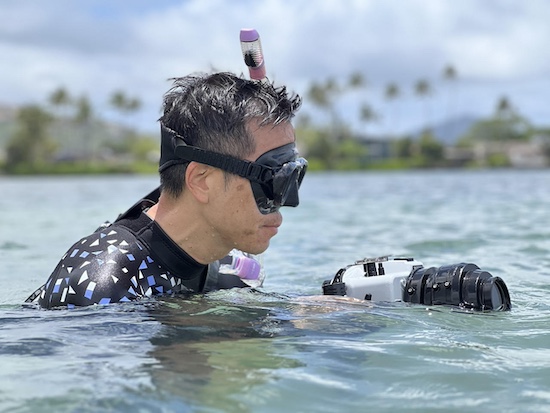
As scientists uncover new insights about our world, effectively communicating their discoveries remains a significant challenge. This is precisely the issue addressed by Seaver College professors Flo La Valle and Paul Kim through their latest collaborative effort.
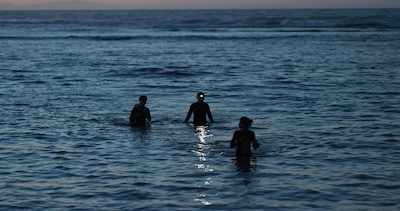
La Valle, an assistant professor of biology, has made a career of studying the ocean. Her current research—which is funded by the National Science Foundation—investigates the effects of pollutants on coral reefs around Oahu’s Maunalua Bay. This summer, La Valle took a group of Seaver College students to the Aloha state looking for answers.
Kim, a professor of screen arts, is a storyteller specializing in documentary film. His latest effort is to tell the story of La Valle’s highly specialized and complex research in a relatable manner. He, too, took a student to paradise to accomplish this goal.
“Leading scientists recognize that a critical aspect of research is communication,” says Kim. “For Dr. La Valle and me, we saw that both of us have specific skills that could overlap. I'm always looking for compelling stories, and she is in the midst of making important findings.”
This shared revelation launched 10 days of consistent interdisciplinary collaboration.
Why?
Submarine groundwater discharge, which is the inflow of groundwater from land into the sea, is the subject of La Valle’s research. Specifically, the Seaver College biology professor maps how land-based pollution eventually leaks into the ocean, which leads to the degradation of coral reefs. While the data she discovers in this project will one day be revealed in an academic journal, Kim believed the demands of the research process could form an interesting and powerful narrative.
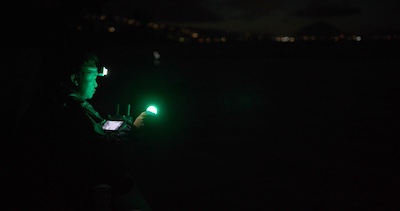
“There's a lot of great evidence out there that demonstrates how storytelling is foundational to humanity,” says Kim. “As a documentary filmmaker, the visual component raises the bar and allows our stories to share visual information and data with viewers. You don’t just tell the story; you get to show the action that embodies what the story's narrative is all about.”
Rather than reading statistics or an analysis laden with jargon, Kim’s documentary shows viewers how La Valle arrives at her informed conclusions. It carries the audience into the Hawaiian waves at 2:30 AM when the ocean is black and churning. It reveals how field scientists wear more than lab coats—how they don wetsuits and study their subject by immersing themselves within the environment. And, above all, it demonstrates the amount of effort and dedication poured into these scientific pursuits as researchers engage in 18-hour workdays to try and accomplish their goals while casting a vision for place-based science that puts communities first
The documentary reveals how science reaches beyond newfound discoveries to impact people. In the film La Valle and her team of researchers can be seen working with Kanoe Kim Morishige—a Native Hawaiian Program Specialist and NOAA Affiliate for Papahānaumokuākea Marine National Monument and a current PhD candidate at the University of Hawai'i at Mānoa. Kanoe assisted the Seaver College group as they prioritized the local community and their needs ahead of science.
While facets of the research process such as this might not make the final text of the scholarly analysis, Kim’s documentary allows viewers to see how academic work involves more than just seclusive study.
How?
Merging innovative oceanic research with high-tech motion photography has its difficulties. La Valle and Kim had to find ways to accommodate the other’s specific processes.
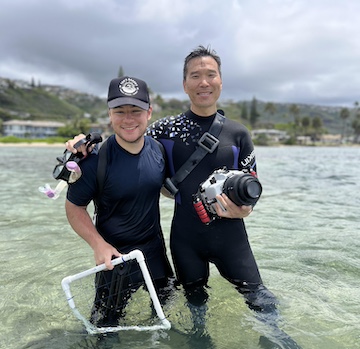
“It was odd,” says La Valle. “As researchers, we want to interact with each other and make sure that everyone feels at home or at ease in the water, but that’s not what the storytellers want. They want you to forget that they are there.”
La Valle and her team of student researchers had to get used to cameras and microphones following them into the water. They had to become accustomed to nonscientists participating in their process. Thus, Kim had to find a way to normalize himself, his crew, and his equipment, which, incidentally, is not waterproof.
“With a documentary, you're really trying to embed yourself into an experience—into a story with a group of characters,” Kim explains. “The aspects of the production—the technology, the logistics—create a heavy footprint. A good documentary filmmaker tries to keep the apparati of filmmaking from getting in the way of telling the truth.”
To help catalyze the collaborative process, the members of the Seaver College research expedition elected to live with one another throughout the trip. Living in close quarters knocked down walls between the filmmakers and researchers, allowing for a more natural and authentic environment when the cameras were turned on.
“It was so rewarding to get to know and be around these people,” says Nicholas Yi, the Seaver College student who assisted Kim in the filming process. Beyond producing a better, more immersive narrative, Yi reported that the documentary’s accessibility to the researchers helped him consider how to best engage in his own vocation as a filmmaker.
“The scientists we covered in the documentary all practiced community-based research, which is centered around respecting the values, wishes, and spaces of the communities they interact with during their work,” Yi says. “This can manifest in a lot of different ways, like having to pause work due to the availability or comfort of the community, for example. It was a very impactful thing to experience and a reminder of how important it is to serve others.
Final Product
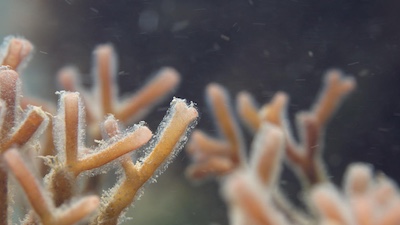
After 10 long days of shooting, Kim and Yi returned to California. They have begun poring over footage, arranging it in the editing bay, and putting together the puzzle pieces that form a whole and complete narrative.
This storytelling process has been in progress since May; by the end of 2024, Kim and Yi hope to have a fine cut ready for review prior to making final edits. They hope to exhibit their documentary in the summer of 2025.
By enduring these painstaking but crucial steps of the storytelling process, the Seaver College professor and student help advance Flo La Valle’s field of science, making it comprehensive and compelling for those accustomed to consuming entertainment rather than research.
“This is a unique story, and it's really exciting to be working with colleagues here at Pepperdine, who are just doing such important groundbreaking work,” says Kim. “In the case of Dr. La Valle’s research, we're showcasing their processes—the scientific processes as well as the deep respect for culture that is behind the science.”